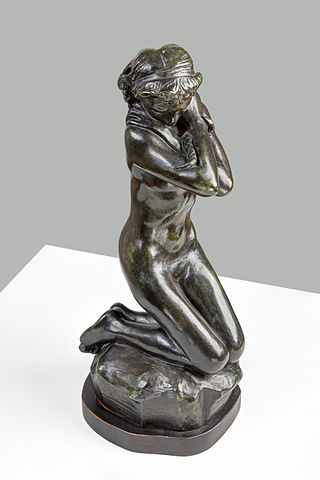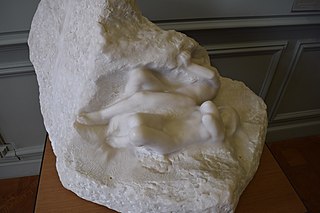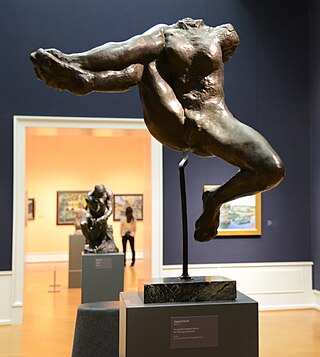| Adam, or The Creation of Man | |
|---|---|
 The bronze cast in the Metropolitan Museum of Art | |
| Artist | Auguste Rodin |
| Year | 1880-1881 |
Adam is an 1880-1881 statue of Adam by Auguste Rodin, first exhibited at the Paris Salon that year entitled The Creation of Man.
| Adam, or The Creation of Man | |
|---|---|
 The bronze cast in the Metropolitan Museum of Art | |
| Artist | Auguste Rodin |
| Year | 1880-1881 |
Adam is an 1880-1881 statue of Adam by Auguste Rodin, first exhibited at the Paris Salon that year entitled The Creation of Man.
That year Rodin was also commissioned by France's Ministry of Fine Arts to produce two colossal figures of Adam and Eve, which he suggested using to flank his The Gates of Hell project, then ongoing. For the figure of Adam he reused The Creation of Man, whilst Eve was created separately. [1]
The work was first cast in 1910 and bronze casts of it are now in the Art Institute of Chicago, [2] the Musee Rodin and the Metropolitan Museum of Art among others. [3]


François Auguste René Rodin was a French sculptor, generally considered the founder of modern sculpture. He was schooled traditionally and took a craftsman-like approach to his work. Rodin possessed a unique ability to model a complex, turbulent, and deeply pocketed surface in clay. He is known for such sculptures as The Thinker, Monument to Balzac, The Kiss, The Burghers of Calais, and The Gates of Hell.

The Thinker is a bronze sculpture by Auguste Rodin, usually placed on a stone pedestal. The work depicts a nude male figure of heroic size sitting on a rock. He is seen leaning over, his right elbow placed on his left thigh, holding the weight of his chin on the back of his right hand. The pose is one of deep thought and contemplation, and the statue is often used as an image to represent philosophy.

The Burghers of Calais is a sculpture by Auguste Rodin in twelve original castings and numerous copies. It commemorates an event during the Hundred Years' War, when Calais, a French port on the English Channel, surrendered to the English after an eleven-month siege. The city commissioned Rodin to create the sculpture in 1884 and the work was completed in 1889.

The Musée Rodin in Paris, France, is an art museum that was opened in 1919, primarily dedicated to the works of the French sculptor Auguste Rodin. It has two sites: the Hôtel Biron and surrounding grounds in central Paris, as well as just outside Paris at Rodin's old home, the Villa des Brillants at Meudon, Hauts-de-Seine. The collection includes 6,600 sculptures, 8,000 drawings, 8,000 old photographs and 7,000 objets d'art. The museum receives 700,000 visitors annually.

The Gates of Hell is a monumental bronze sculptural group work by French artist Auguste Rodin that depicts a scene from the Inferno, the first section of Dante Alighieri's Divine Comedy. It stands at 6 metres high, 4 metres wide and 1 metre deep (19.7×13.1×3.3 ft) and contains 180 figures.

The Age of Bronze is a bronze statue by the French sculptor Auguste Rodin (1840–1917). The figure is of a life-size nude male, 72 in. (182.9 cm) high. Rodin continued to produce casts of the statue for several decades after it was modelled in 1876.

The Walking Man is a bronze sculpture by the French sculptor Auguste Rodin. This sculpture was made in 1907.

Saint John the Baptist (preaching) is a bronze sculpture, by Auguste Rodin.

The Martyr or The Little Martyr is a c.1885 plaster sculpture of a naked dead or sleeping female figure by Auguste Rodin, now in the Musee Rodin.

Cybele is a sculpture by French artist Auguste Rodin. It is one of the first of Rodin's partial figures known as "fragments" to be displayed as sculpture in its own right, rather than an incomplete study.

The Falling Man is a sculpture by French artist Auguste Rodin modeled in 1882 and is part of Rodin's emblematic group The Gates of Hell.

Pierre de Wissant is a bronze sculpture by French artist Auguste Rodin, part of his sculptural group The Burghers of Calais. This sculpture represents one of the six burghers who, according to Jean Froissart surrendered themselves in 1347, at the beginning of the Hundred Years' War (1337–1453), in order to save the inhabitants of the French city of Calais from the English laying siege to the city.

Eve is a nude sculpture by the French artist Auguste Rodin. It shows Eve despairing after the Fall.

Despair or Despair at the Gate is a sculpture by Auguste Rodin that he conceived and developed from the early 1880s to c. 1890 as part of his The Gates of Hell project. The figure belongs to a company of damned souls found in the nine circles of Hell described by Dante in The Divine Comedy. Other title variations are Shade Holding her Foot, Woman Holding Her Foot, and Desperation. There are numerous versions of this work executed as both plaster and bronze casts and carved marble and limestone.

Young Woman with a Serpent is a c. 1885 sculpture by Auguste Rodin, realised in several media. The artist later used the figure in his 1905 Adam and Eve.

Adam and Eve or Adam and Eve Sleeping is a 1905 marble sculpture by Auguste Rodin. It is located in the Musee Rodin in France.

Iris, Messenger of the Gods is a bronze sculpture by Auguste Rodin. A plaster model, created between 1891 and 1894, was cast in bronze by Fonderie Rudier at various times from about 1895. Iris is depicted with her right hand clasping her right foot and her naked body posed provocatively with her legs spread wide, displaying her genitalia.

Rodin — The Thinker is a pictorialist photograph made by American photographer Edward Steichen in 1902. It depicts renowned French sculptor Auguste Rodin, in his studio, facing his famous The Thinker sculpture, with his other creation, the Monument to Victor Hugo, as a background.

Balzac, the Open Sky is a black and white photograph taken by American photographer Edward Steichen in 1908. The photograph is part of a series created by Steichen that depict the statue of Honoré de Balzac by Auguste Rodin, executed in plaster, in 1898. The statue would eventually be cast in bronze and inaugurated in Paris, in 1939.
![]() Media related to Adam by Auguste Rodin at Wikimedia Commons
Media related to Adam by Auguste Rodin at Wikimedia Commons